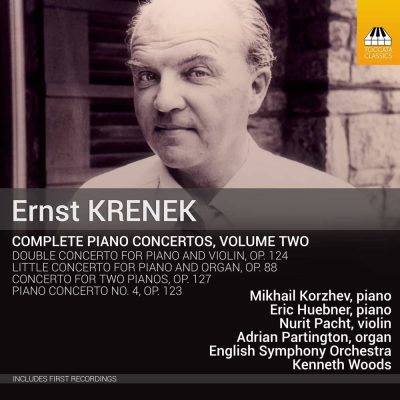Another rave from Fanfare for volume 2 of the Complete Piano Concertos of Ernst Krenek on Toccata. Congrats to Mikhail Korzhev, Nurit Pacht, Eric Huebner, Adrian Partington, Kenneth Woods, conductor, Benjamin Michael Haas and the Ernst Krenek Institut
“As in the previous volume the performances and recording quality are first-class… a hearty endorsement yet again to Toccata Classics and these excellent musicians for revealing the existence of this unjustly neglected repertoire.”
KRENEK Piano Concerto No. 4. Concerto for 2 Pianos and Orchestra.1 Double Concerto for Violin, Piano, and Orchestra.2 Little Concerto for Piano, Organ, and Chamber Orchestra3 • Mikhail Korzhev, 1Eric Huebner (pn); 2Nurit Pacht (vn); 3Adrian Partington (org); Kenneth Woods, cond; English SO • TOCCATA 0392 (64:11)
With hindsight, we can see that the 12-tone harmonic system of the 20th century produced very few works of ongoing popularity. Webern’s music, exquisite though it is, has never transcended its cult status. Schoenberg’s Variations for Orchestra, and Piano Concerto get the occasional airing, but the only works to firmly enter the canon are those of Alban Berg: the operas Wozzeck and Lulu and the Violin Concerto. As for the 12-tone composers who came in the wake of these three, with the possible exception of the “tonal serialist” Frank Martin they now seem to be a lost cause.
One was Ernst Krenek (1900–1991), who converted to Schoenberg’s serial harmonic language during the course of his early and most successful years in Vienna. The path of that conversion was charted in the previous issue in this welcome series, which contained Krenek’s first three piano concertos played by the same team of Mikhail Korzhev, Kenneth Woods, and the English Symphony Orchestra (see Fanfare 39:6). By the time of his Third Concerto (1949), the composer was resident in the United States, like so many European refugees. In that brief work, it was clear Krenek was realistic enough to understand that any serial piece would need an attractive surface to make an impression on American audiences. It is even more clearly a factor with the Fourth Concerto of 1950, which opens this program. The initial exuberance of its instrumental virtuosity and rhythmic energy renders its harmonic aspect secondary. The Bergian second movement is compellingly introspective, with irresistibly dramatic climaxes, and it is only in the finale that the music turns a little dry and distancing. The Double Concerto for Violin, Piano, and Orchestra of the same year is more austere—the model here undoubtedly being Berg’s Chamber Concerto—but Krenek retains interest through the adroit interplay of the two solo instruments and the hints of musical styles from the Vienna of his childhood. (Still, Die Fledermaus it ain’t.)
A work with a lighter texture and more introverted nature is the Little Concerto for piano and organ, op. 88, composed in 1939–40 when the composer was struggling to establish himself in America. Krenek wrote this piece for conservatory students, which explains the smaller orchestral forces (lacking in percussion and brass). Lasting under 10 minutes, but nonetheless two minutes longer than the Violin and Piano Concerto, the work’s attractions lie in its textural clarity and the distinctive timbre of the organ, which Krenek exploits with subtlety and restraint.
The real showpiece in the program is the 1951 Concerto for Two Pianos, op. 127. Like the Fourth Piano Concerto it bursts into vivid life, and is designed to show off the virtuosity of its soloists. Here the idiom is reminiscent of Prokofiev. Krenek’s flamboyant piano writing is markedly similar to that of the Russian’s Fifth and final Piano Concerto. The longest movement in a relatively short work (14 minutes) is the last, an Adagio compiled of diverse episodes that grows out of a sudden, unexpected halt to the headlong Allegro preceding it. Balancing two pianos with orchestra is a notoriously tricky challenge: Many 20th-century composers tried it with varying degrees of success, among them Bartók, Malipiero, Harris, Françaix, Milhaud, and Britten. Along with the Two-Piano Concerto by Poulenc, Krenek’s would have to be among the most successful. It is certainly my favorite of the four works on this disc, but all have their strengths and attractions in one way or another. As in the previous volume the performances and recording quality are first-class—although the soloists could be a little less in-your-face, as orchestral textures are occasionally obscured. Nevertheless, a hearty endorsement yet again to Toccata Classics and these excellent musicians for revealing the existence of this unjustly neglected repertoire.” Phillip Scott


